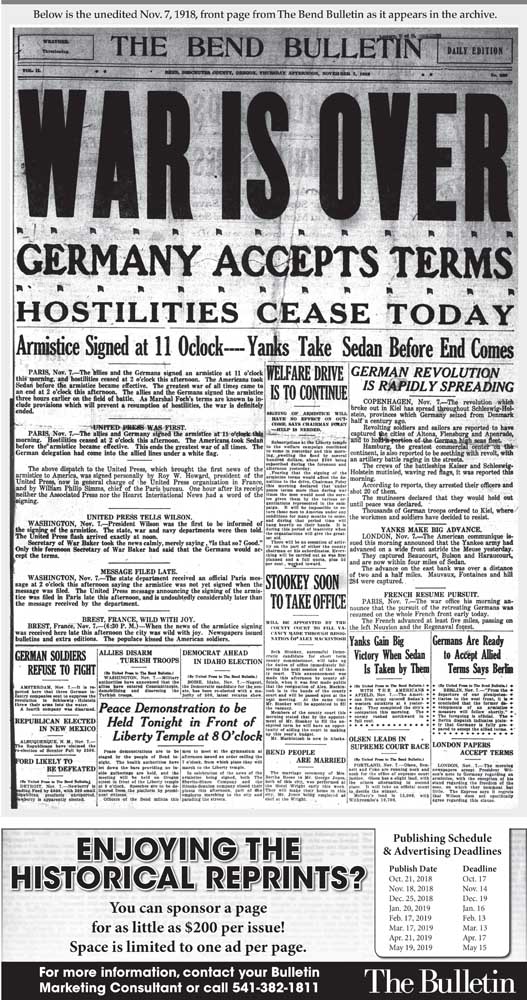The Bend Bulletin, Nov. 7, 1918
Published 12:00 am Sunday, November 18, 2018

- The Bend Bulletin, Nov. 7, 1918
This reprint of the Nov. 7, 1918, Bend Bulletin is our sixth historical edition.
(Click on the images below to read the reproduced pages.)
On the third Sunday of every month, we revive an edition chosen from the same month 100 years earlier. Normally, we pick editions that balance both local and national news. Not this time.
This is the edition of The Bend Bulletin that informed readers that Germany had signed the armistice, ending the First World War. Problem was, it was a few days early. The United Press jumped the gun, so to speak, in announcing the end of the war, creating what’s remembered as the “False Armistice.” The Germans didn’t sign the actual armistice until Nov. 11, making this edition of The Bend Bulletin both historic and historically wrong. In any case, jubilation ensued, and the Shevlin-Hixon and Brooks-Scanlon mills closed for the day so employees could parade in the streets.
Even as the war ended (almost), Bend residents continued to contend with the 1918 flu pandemic, which, according to the Centers for Disease Control, killed about 675,000 people in the United States and 50 million worldwide. From 1917 to 1918, according to the CDC, life expectancy in the United States dropped by about 12 years, to 36.6 years for men and 42.2 years for women.
They also bought Liberty Bonds, electric ranges and winter clothing, including heavy cotton union suits, which cost $1.79 for women and $1.89 for men.
Next month’s historical edition will create the Christmas Eve paper, which includes the story of two Bend boys who lost the $10 bill with which they were going to buy Christmas presents.
Our goal is to replicate the experience of reading the newspaper 100 years ago. Listing historically significant events, as The Bulletin does regularly, is a useful but limited exercise. A digest of highlights doesn’t tell you, for instance, which films were playing locally 100 years ago, which products businesses were advertising and who was staying at the Hotel Cozy. Only reprinting the newspaper can do that. The Bulletin hopes to continue printing one historical section on the third Sunday of every month. The edition will have appeared during the same month 100 years previously. The effort is supported by contemporary advertising, which appears in color at the bottom of historical edition pages.
The process of reprinting a century-old paper works as follows: First, we review our microfilm archive and pick an edition to re-create. Next, we transcribe the news content and rebuild century-old ads. The latter task is handled by The Bulletin’s advertising department. Finally, the newsroom’s designers rebuild the pages using transcribed text.







